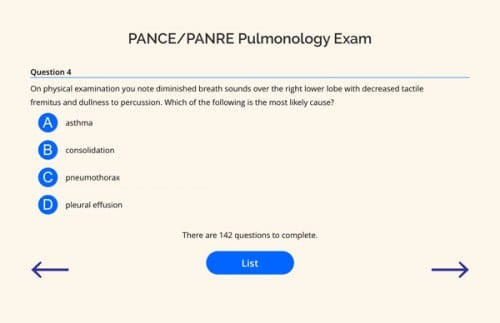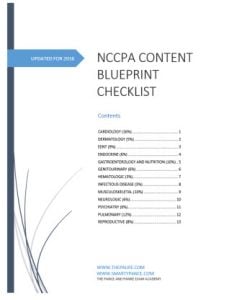Pulmonary Content Blueprint Classic and Pathognomonic Patient Presentations and Question Stems
Below is a list of the most common PANCE and PANRE board review question stems and patient presentations you are likely encounter on your board exam
- These represent the most common/classic patient presentations or what could be considered pathognomonic
- This is a comprehensive list following the exact NCCPA PANCE and PANRE Pulmonology content blueprint
- The pulmonology section represents 12% of your board exam
- Make sure to download my FREE content blueprint checklist
- Members have access to the comprehensive 142 question pulmonology exam
Pulmonology Content Blueprint Common Patient Presentations
Infectious Disorders |
|
| Acute bronchitis | Patient will present with → cough and dyspnea for 6 days |
| Acute bronchiolitis | Patient will present as → first episode of wheezing in a child 12-24 months with findings of viral respiratory infection |
| Acute epiglottitis | Patient will present with → sudden onset of high fever, respiratory distress, severe dysphagia, drooling and a muffled voice in an unvaccinated child. Thumbprint sign on lateral neck film |
| Croup | Patient will present with → 2-year-old with barking cough and stridor. "Steeple sign" on PA neck X-Ray |
| Influenza | Patient will present with → sudden onset of fever, chills, malaise, sore throat, headache coryza and myalgia (especially in the back and legs) |
| Pertussis | Patient will present with → severe paroxysmal cough followed by an inspiratory high-pitched whoop, if untreated will develop a chronic cough lasting for weeks |
Pneumonias |
|
| • Bacterial | Patient will present with → fever, dyspnea, tachycardia, tachypnea, cough +/- sputum |
| • Viral | Patient will present with → 1 week history of hacking non-productive cough, low grade fever, malaise and myalgias. The chest x-ray reveals bilateral interstitial infiltrates and a cold agglutinin titer that is negative |
| • Fungal | Patient will present with → non-remitting cough/bronchitis non-responsive to conventional treatments |
| • HIV-related | Patient will present as → a young person who you don't know has HIV, because of the pneumonia they have you become suspect. The radiograph shows diffuse interstitial or bilateral perihilar infiltrates |
| Respiratory syncytial virus infection | Patient will present with → 4-month-old with wheezing, cough and dyspnea |
| Tuberculosis | Patient will present with → FEVER, hemoptysis, recent travel, NIGHT SWEATS, weight loss, shortness of breath, social contact with same symptoms |
Neoplastic Disease |
|
| Carcinoid tumors | Patient will present with → haemoptysis, cough, focal wheezing or recurrent pneumonia. Carcinoid syndrome (the hallmark sign of cutaneous flushing, diarrhea, wheezing and low blood pressure) is actually quite rare. |
| Lung cancer | Patient will present as → a previous smoker with a new or changing cough, weight loss, hemoptysis and hoarseness |
| Pulmonary nodules | Patient will present → after having had a radiograph for something else and found to have a small < 3 cm pulmonary lesion, they are likely asymptomatic. |
Obstructive Pulmonary Disease |
|
| Asthma | Patient will present with → shortness of breath, tachypnea and prolonged expiratory wheezing, in more severe cases may assume the tripod position, atopic triad - wheeze, eczema, seasonal rhinitis |
| Bronchiectasis | Patient will present with → foul breath, purulent sputum and hemoptysis along with a CXR demonstrating dilated and thickened airways with “plate-like” atelectasis (scarring) |
| Chronic bronchitis | Patient will present with → a chronic cough that is productive of phlegm occurring on most days for 3 months of the year for 2 or more consecutive years without an otherwise-defined acute cause |
| Cystic fibrosis | Patient will present as → a young patient with a history of chronic lung disease, pancreatitis or infertility. May have clubbing of fingers CXR may reveal hyperinflation, mucus plugging and focal atelectasis. Labs will reveal an elevated quantitative sweat chloride test |
| Emphysema | Patient will present with → exertional dyspnea, minimal cough, quite lungs, thin, barrel chest. Chest X-ray will reveal flattened diaphragm, hyperinflation and small, thin appearing heart |
Pleural Diseases |
|
| Pleural effusion | Patient presents with → dyspnea, and a vague discomfort or sharp pain that worsens during inspiration. Physical exam reveals decreased tactile fremitus, dullness to percussion and diminished breath sounds over the effusion |
| Pneumothorax | Patient will present with → acute onset of ipsilateral chest pain and dyspnea. Physical findings will include decreased tactile fremitus, deviated trachea, hyperresonance, and diminished breath sounds. |
Pulmonary Circulation |
|
| Cor pulmonale | Patient will present with → left parasternal systolic lift, a loud pulmonic component of S2 , functional tricuspid and pulmonic insufficiency murmurs, and later, distended jugular veins, hepatomegaly, and lower-extremity edema. |
| Pulmonary embolism | Patient will present with → risk factors such as COCP use or recent surgery with a sudden onset of pleuritic chest pain, dyspnea, apprehension, cough, hemoptysis, and diaphoresis. Signs include tachycardia, tachypnea and crackles. |
| Pulmonary hypertension | Patient will present with → dyspnea, chest pain, weakness, fatigue, edema, and ascites along with a narrow splitting of the second heart sound and a systolic ejection click. |
Restrictive Pulmonary Disease |
|
| Idiopathic pulmonary fibrosis | Patient will present with → insidious dry cough, dyspnea, fatigue, malaise, clubbing, inspiratory crackles |
| Pneumoconiosis | Patient will present with → dyspnea, inspiratory crackles, clubbing of fingers, cyanosis and a work or exposure history that will provide you with the diagnosis |
| Sarcoidosis | Patient will present as → a 30-year-old African American female with a cough, fever and generalized body aches. You order a CXR which shows bilateral hilar adenopathy |
Other Pulmonary Disease |
|
| Acute respiratory distress syndrome | Patient will present with → rapid onset of profound dyspnea occurring 12-24 hours after the precipitating event. Physical exam will show tachypnea, frothy pink or red sputum and diffuse crackles. |
| Hyaline membrane disease | Patient will present as → a preterm infant with typical signs of respiratory distress shortly after birth |
| Foreign body aspiration | Patient will present with → an episode of choking and coughing or unexplained wheezing or hemoptysis. Asphyxia may result from the aspiration of obstructing material. An inspiratory wheeze is called stridor, which indicates a partial obstruction of the trachea or larynx |






